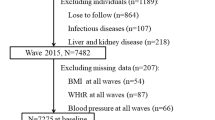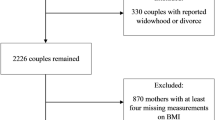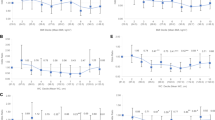Abstract
Hypertension (HTN) can lead to a series of target organ damage and is associated with increased cardiovascular disease incidence and mortality. Perimenopause implies an important physiological transition. Previous studies have confirmed that obesity is a risk factor for the development of HTN. Nevertheless, few studies have investigated the prevalence of HTN in perimenopausal women and the relationships between peripheral or abdominal obesity and HTN. Therefore, we analysed the influencing factors of HTN in perimenopausal working women and the correlation between different types of obesity and HTN to provide evidence for the need to prevent HTN in perimenopausal women. Perimenopausal women who underwent physical examination at Shanghai Health and Medical Center from January 2021 to October 2021 were selected as subjects. A multivariate logistic regression model was used to analyse the associations between different types of obesity and HTN in perimenopausal women. Five hundred eighty-two perimenopausal women were included in this study; 124 cases of HTN were detected (incidence rate 21.31%), 23 of which were isolated systolic HTN (18.55% of total HTN cases). Multivariate logistic regression analysis revealed that age and BMI were the influencing factors of HTN in perimenopausal women. Compared with that of perimenopausal women without peripheral obesity, HTN in overweight (OR = 1.84, 95% CI: 1.13–2.98) and peripheral obesity (OR = 4.36, 95% CI: 1.52–12.54) women increased with increasing body weight. Perimenopausal women with abdominal obesity had a greater risk of developing HTN (OR = 2.69, 95% CI: 1.16–6.21) (P < 0.05). Age and BMI are risk factors for the development of HTN in perimenopausal working women. Both abdominal obesity and peripheral obesity are positively associated with HTN in perimenopausal women. The BMI and abdominal circumference of perimenopausal women need to be monitored as early as possible to prevent obesity and reduce the occurrence of HTN.
This is a preview of subscription content, access via your institution
Access options
Subscribe to this journal
Receive 12 digital issues and online access to articles
118,99 € per year
only 9,92 € per issue
Buy this article
- Purchase on SpringerLink
- Instant access to full article PDF
Prices may be subject to local taxes which are calculated during checkout
Similar content being viewed by others
Data availability
There are no linked research data sets for this paper. The data supporting the findings of this article are available from the corresponding author.
References
Wang Z, Chen Z, Zhang L, Wang X, Hao G, Zhang Z, et al. Status of hypertension in China: results from the China hypertension survey, 2012-2015. Circulation. 2018;137:2344–56.
Unger T, Borghi C, Charchar F, Khan NA, Poulter NR, Prabhakaran D, et al. 2020 international society of hypertension global hypertension practice guidelines. Hypertension. 2020;75:1334–57.
Schutte AE, Jafar TH, Poulter NR, Damasceno A, Khan NA, Nilsson PM, et al. Addressing global disparities in blood pressure control: perspectives of the International Society of Hypertension. Cardiovasc Res. 2023;119:381–409.
Menopause Subgroup, Chinese Society of Obstetrics and Gynecology, Chinese Medical Association. [Chinese guideline on menopause management and menopause hormone therapy (2018)]. Zhonghua Fu Chan Ke Za Zhi. 2018;53:729–39.
Wang L, Szklo M, Folsom AR, Cook NR, Gapstur SM, Ouyang P. Endogenous sex hormones, blood pressure change, and risk of hypertension in postmenopausal women: the Multi-Ethnic Study of Atherosclerosis. Atherosclerosis. 2012;224:228–34.
Al-Safi ZA, Polotsky AJ. Obesity and menopause. Best Pract Res Clin Obstet Gynaecol. 2015;29:548–53.
Joint Committee for Guideline Revision. 2018 Chinese guidelines for prevention and treatment of hypertension-a report of the revision committee of Chinese guidelines for prevention and treatment of hypertension. J Geriatr Cardiol. 2019;16:182–241.
Pyne Y, Burgin J, Hickey M. Towards a more accurate global picture of perimenopause. Bull World Health Organ. 2024;102:922–4.
Nutrition and Metabolic Management Branch of China International Exchange andPromotive Association for Medical and Health Care, Clinical Nutrition Branch of Chinese Nutrition Society, Chinese Diabetes Society, Chinese Society for Parenteral and Enteral Nutrition, Chinese Clinical Nutritionist Center of Chinese MedicalDoctor Association. Guidelines for medical nutrition treatment of overweight/obesity in China (2021). Asia Pac J Clin Nutr. 2022;31:450–82.
Wan H, Wang Y, Xiang Q, Fang S, Chen Y, Chen C, et al. Associations between abdominal obesity indices and diabetic complications: Chinese visceral adiposity index and neck circumference. Cardiovasc Diabetol. 2020;19:118.
Heslop K, Ross C. The alcohol smoking and substance involvement screening test in an acute mental health setting. Aust Nurs Midwifery J. 2014;21:47.
Kan J, Ni J, Xue K, Wang F, Zheng J, Cheng J, et al. Personalized nutrition intervention improves health status in overweight/obese Chinese adults: a randomized controlled trial. Front Nutr. 2022;9:919882.
D’Ignazio T, Grand’Maison S, Bérubé L, Forcillo J, Pacheco C. Hypertension across a Woman’s lifespan. Maturitas. 2023;168:84–91.
Williams B, Mancia G, Spiering W, Agabiti Rosei E, Azizi M, Burnier M, et al. 2018 ESC/ESH guidelines for the management of arterial hypertension. Eur Heart J. 2018;39:3021–104.
NCD Risk Factor Collaboration (NCD-RisC). Worldwide trends in blood pressure from 1975 to 2015: a pooled analysis of 1479 population-based measurement studies with 19·1 million participants. Lancet. 2017;389:37–55.
Yi Q, Zha M, Yang Q, Zhang Y, Hou L, Ye X, et al. Trends in the prevalence of hypertension according to severity and phenotype in Chinese adults over two decades (1991-2015). J Clin Hypertens. 2021;23:1302–15.
Subhashri S, Pal P, Pal GK, Papa D, Nanda N. Decreased baroreflex sensitivity is associated with cardiometabolic risks and prehypertension status in early-postmenopausal women. Clin Exp Hypertens. 2021;43:112–9.
Chen YD, Kong W. Research progress of sympathetic nervous system in the occurrence and development of vascular diseases. Chinese J Arteriosclerosis. 2021;29:106–15.
Janda K, Krzanowski M, Gajda M, Dumnicka P, Fedak D, Lis GJ, et al. Cardiovascular risk in chronic kidney disease patients: intima-media thickness predicts the incidence and severity of histologically assessed medial calcification in radial arteries. BMC Nephrol. 2015;16:78.
Ji XD, Liu J, Qiu Y, Zheng ZF, Ji XJ, Jiang SP. Analysis of cardiovascular disease risk factors in perimenopausal women. Chin J Anal Lab. 2016;26:819–21.
Li X, Niu H, Bai X, Wang Y, Wang W. Association of obesity and hypertension: A Cohort Study in China. Int J Hypertens. 2021;2021:1607475.
Hall ME, Hall JE. Sex differences in hypertension: related to genes, jean sizes, and salt sensitivity? Hypertension. 2022;79:47–49.
Balafa O, Kalaitzidis RG. Salt sensitivity and hypertension. J Hum Hypertens. 2021;35:184–92.
Holmes MV, Dale CE, Zuccolo L, Silverwood RJ, Guo Y, Ye Z, et al. Association between alcohol and cardiovascular disease: mendelian randomization analysis based on individual participant data. BMJ. 2014;349:g4164.
Jia ZRY, Luo YZ, Li SL, Hai SYL, Ai GL, Zhang YY, et al. Correlation and influencing factors between menopausal status and changes of blood lipids in women in Urumqi, Xinjiang. Int. J. Geriatr. 2022;43:149–53.
Huang SN, Jiang RQ, Lin XR, Lin FX, Wu SY, Kang DZ, et al. Sex-specific associations between glycated hemoglobin and hypertension in non-diabetic Chinese adults. Chin J Hypertens. 2023;31:257–63.
Acknowledgements
The authors thank all the investigators who participated in the study and all the participants.
Funding
This study has been supported by Research on health management strategy and application of elderly population (GWVI-11.1-28). The funding body did not influence the design of the study, the collection, analysis, and interpretation of data, and on writing the manuscript.
Author information
Authors and Affiliations
Contributions
Zhuoqun Zou contributed to the study concept and design, interpreting the data, composing the statistical dataset, performing the analyses, and writing and revising the manuscript. Huaiqin Zhong contributed to data acquisition, data curation, concept, and drafting of the manuscript. Yan Qiu contributed to data acquisition, data curation, concept, and drafting of the manuscript. Xvping Zhu contributed to interpreting the data and critically revising the manuscript. Mei Liu and Jinyu Li contributed to interpreting the data and critical revision of the manuscript. All the authors reviewed and approved the final version, and no other person made a substantial contribution to the paper.
Corresponding author
Ethics declarations
Competing interests
The authors declare no competing interests.
Ethical approval
This study was performed in line with the principles of the Declaration of Helsinki and approved by the Ethics Committee of Shanghai Health and Medical Center(2020-No.07). Informed consent was obtained from all individual participants included in the study.
Additional information
Publisher’s note Springer Nature remains neutral with regard to jurisdictional claims in published maps and institutional affiliations.
Rights and permissions
Springer Nature or its licensor (e.g. a society or other partner) holds exclusive rights to this article under a publishing agreement with the author(s) or other rightsholder(s); author self-archiving of the accepted manuscript version of this article is solely governed by the terms of such publishing agreement and applicable law.
About this article
Cite this article
Zhong, H., Qiu, Y., Zhu, X. et al. Correlation between different types of obesity and hypertension in perimenopausal working women. J Hum Hypertens 39, 343–347 (2025). https://doi.org/10.1038/s41371-025-01010-y
Received:
Revised:
Accepted:
Published:
Issue Date:
DOI: https://doi.org/10.1038/s41371-025-01010-y



